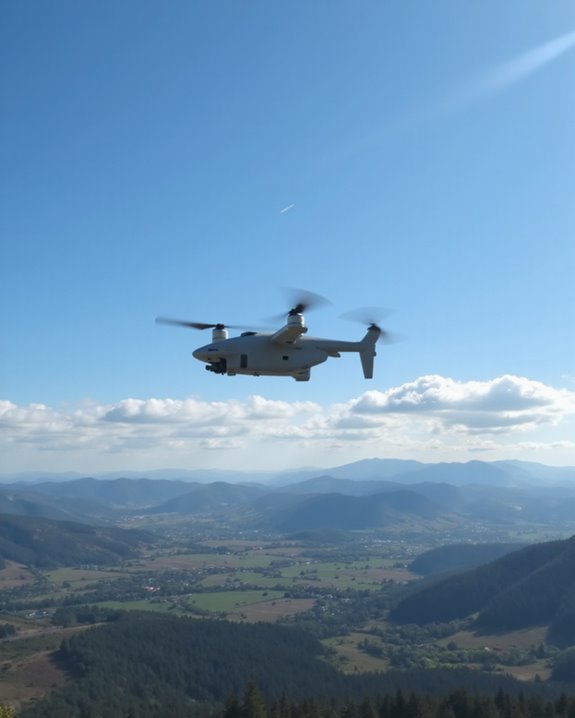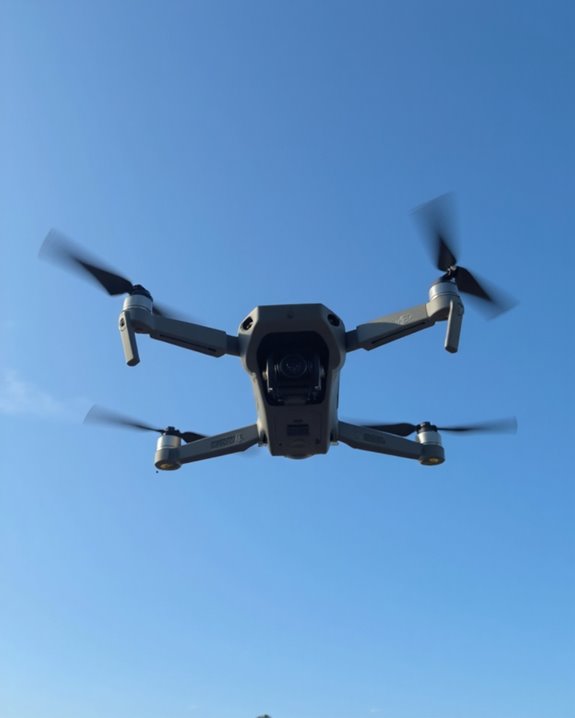Drone speeds vary dramatically based on their design and purpose. Consumer quadcopters typically cruise at 15-45 mph, with DJI models reaching around 40-70 km/h in sport modes. Racing drones push boundaries at 100+ mph, while the record-breaking Peregrine 2 achieved a stunning 298 mph! Military UAVs operate between 200-530 km/h depending on their mission profiles. Environmental factors like wind, temperature, and altitude greatly impact these speeds. Discover what’s influencing your drone’s performance potential!
Key Takeaways
- Consumer drones typically fly at speeds between 20-45 mph (32-72 km/h) during normal operation.
- Racing drones can reach extreme speeds of 100+ mph, with the record-holding Peregrine 2 achieving 298.47 mph.
- DJI consumer models vary in speed capabilities: Mini 3 Pro (57 km/h), Air 2S (68.4 km/h), and Mavic 3 (75 km/h).
- Military drones operate at much higher speeds, ranging from 200 to 530 km/h depending on their mission profiles.
- Environmental factors like wind resistance, air density, and temperature significantly affect a drone’s maximum achievable speed.
Understanding Drone Speed Basics
The fascinating world of drone speeds encompasses everything from everyday consumer models to record-breaking speedsters that push the boundaries of aerodynamic possibility. When discussing drone velocity, Unit Conversion becomes essential—speeds are typically measured in mph, but sometimes expressed in km/h or even meters per second for scientific applications.
At its core, drone flight is all about Force Balance! The interplay between thrust, drag, weight, and lift determines just how fast these amazing machines can zip through the air. Consumer drones typically cruise at 20-45 mph, while racing models can exceed 100 mph with ease. The remarkable Peregrine 2, currently holding the Guinness World Record, achieved an astonishing 298.47 mph—nearly as fast as some small aircraft! Achieving such speeds requires perfect aerodynamics and materials like carbon fiber. Additionally, wind resistance ratings play a crucial role in affecting the actual top speeds drones can maintain in real-world flying conditions.
Average Speeds of Common Consumer Drones
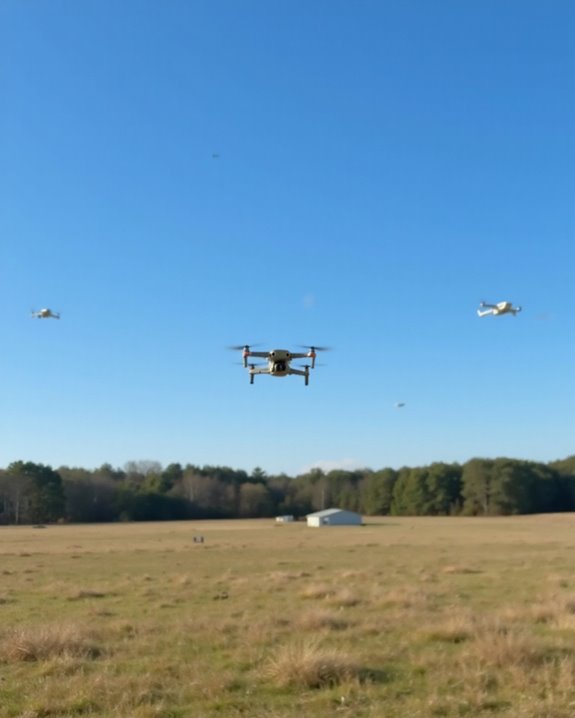
When comparing popular consumer drones, speed capabilities vary dramatically across models, with most everyday quadcopters cruising comfortably between 25 to 50 km/h (15 to 31 mph). For daily operations, this range provides ample speed for capturing stunning aerial footage while maintaining stability.
A performance analysis of market-leading models reveals significant differences: the lightweight DJI Mini 3 Pro zips along at 57 km/h, while the beefier DJI Mavic 3 pushes nearly 75 km/h! Mid-weight options like the Air 2S strike a balance at 68.4 km/h.
Most manufacturers provide special “Sport” modes for thrill-seekers wanting to test their drone’s upper limits. Remember though, flying at top speed isn’t always practical – your battery drains faster than your smartphone during a video call marathon!
For those interested in drone racing, speeds exceeding 30 mph and a power-to-weight ratio around 2:1 are key factors for acceleration and performance.
Racing Drones: Breaking Speed Barriers
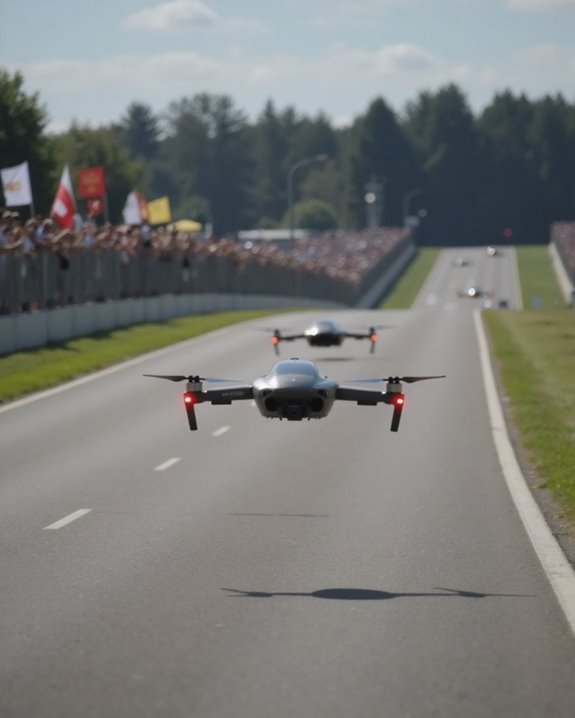
While everyday consumer drones happily cruise along at modest speeds, racing drones blast past these limitations at velocities that would make your head spin! The Peregreen 2 has shattered records with its missile-style design, reaching an astonishing 500 km/h (310 mph)! This carbon fiber speedster combines eVTOL capabilities with aerodynamic excellence.
Racing Tactics often involve maneuvering complex obstacle courses that test not just speed but precision. The DRL RacerX, handmade in NYC with 3D-printed components, demonstrates how innovation drives competition, achieving verified speeds of 165.2 mph. Pilot Skills become paramount at these velocities, where a split-second decision can mean the difference between victory and crash!
The competitive nature of drone racing continues pushing technological boundaries, with manufacturers constantly refining designs to break tomorrow’s speed barriers. Models like the Sky Viper Type-R, offering speeds over 30 mph with specialized racing modes, highlight the focus on speed and power-to-weight ratio in drone design.
Military Drone Speed Capabilities
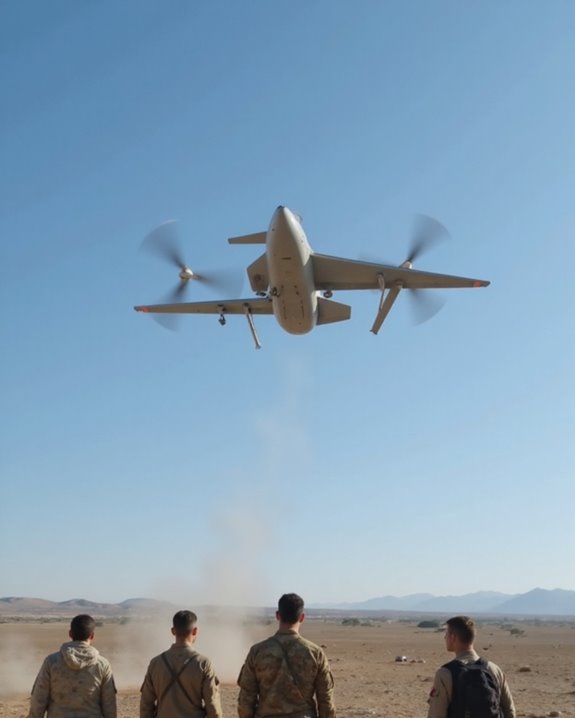
Just how powerful are the speed capabilities of modern military drones? These aerial marvels can achieve impressive velocities ranging from 200 to a whopping 530 km/h, depending on their Mission Profiles. Combat-focused drones often reach speeds exceeding 500 km/h, while surveillance models cruise between 200-350 km/h for those long observation missions.
The balance between speed and endurance is vital to Defense Strategies, with some drones like the Wing Loong II maintaining 370 km/h for up to 20 hours! Military commanders love this combination of persistence and quickness. At altitudes up to 50,000 feet, these high-tech flyers remain virtually invisible to ground observers while gathering intelligence or providing battlefield support. The MQ-9A Reaper, for example, can zip through the skies while carrying nearly two tons of payload—talk about a speedy delivery system!
Environmental Factors Affecting Drone Velocity
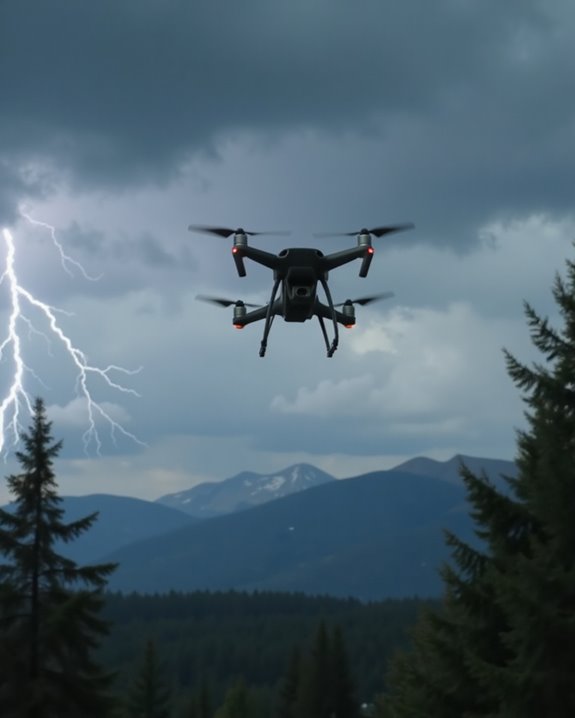
The remarkable speed capabilities of drones face constant challenges from Mother Nature’s unpredictable moods! Even the fastest racing drones can struggle when environmental conditions turn against them. Wind resistance remains the primary nemesis, forcing motors to work overtime and draining batteries rapidly.
Air density plays a vital role too, varying with altitude and temperature changes. At higher elevations, thinner air provides less lift, requiring drones to work harder just to stay aloft! Humidity effects are equally troublesome, as high moisture levels reduce propeller efficiency by altering the air’s composition.
Temperature extremes create another headache for drone pilots, with frigid conditions diminishing battery performance and scorching heat risking overheating. The Venturi effect near buildings and ground-level turbulence add further complications, creating invisible aerial obstacle courses that can dramatically slow even the speediest drones!
Top Drone Brands and Their Maximum Speeds
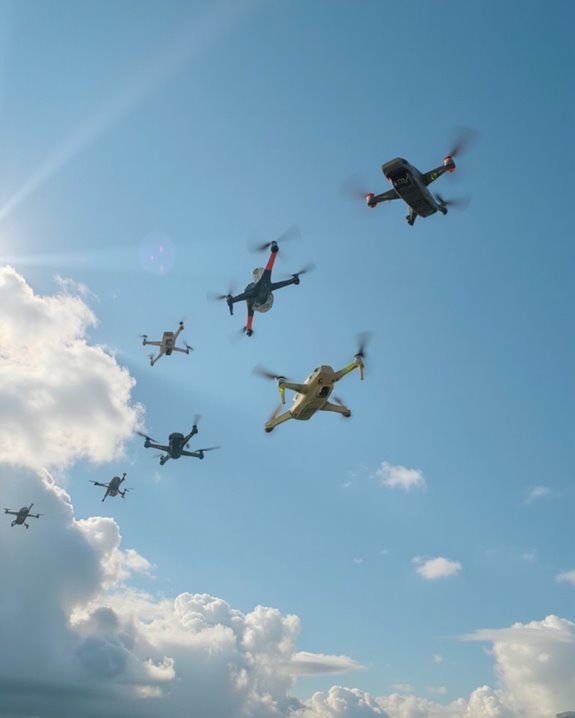
Drone enthusiasts around the world constantly track the thrilling race for aerial supremacy among leading manufacturers! When comparing Brand Speeds, the XLR V3 stands out with an astonishing top speed of 257 mph, leaving most competitors in its dust. The DRL Racer X, holding the official Guinness World Record, zooms at 165.2 mph, while custom FPV models can reach speeds up to 376 km/h—talk about wind in your propellers!
For everyday flyers checking Model Ratings, DJI’s lineup offers variable performance: the Avata 2 cruises at 8m/s in Normal mode but kicks it up in Sport mode, while the FPV model reaches a respectable 62 mph. Parrot’s Anafi slightly outpaces DJI’s Mini series (15 m/s vs. 13-15 m/s), making it a zippy choice for recreational pilots!
Speed Regulations and Safety Considerations
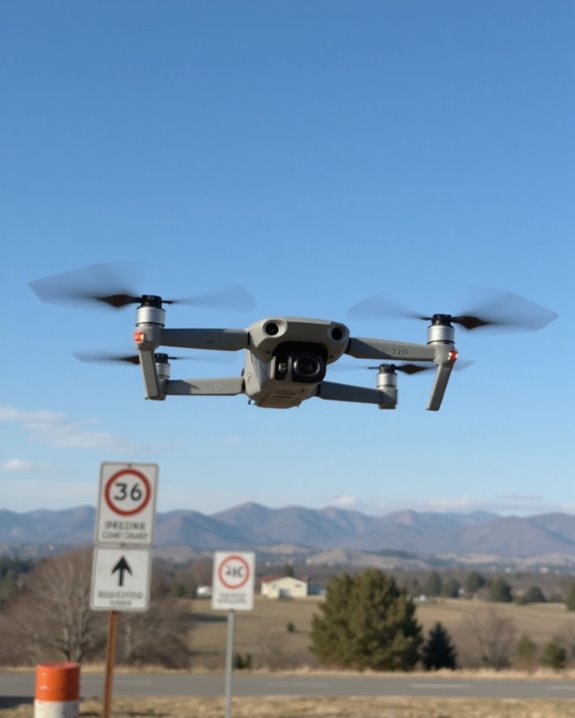
When considering the thrill of high-speed drone flight, understanding regulatory guardrails becomes essential for every pilot! The FAA caps drone speeds at 100 mph (87 knots) under Part 107 rules, though RC enthusiasts can seek special permissions through Waiver Applications to push these limits. Near people, drones must slow dramatically to just 3 m/s when within 5 meters.
International regulations vary widely, with the EU and other countries implementing their own safety guidelines based on location and proximity factors. Remember, higher speeds greatly increase Liability Issues and collision risks! Smart pilots invest in obstacle avoidance systems and proper training before attempting maximum velocities. Weather conditions and drone design also play vital roles in determining safe operating speeds, so always consider your environment before pushing that throttle forward!
Record-Breaking Drone Speeds and Future Innovations
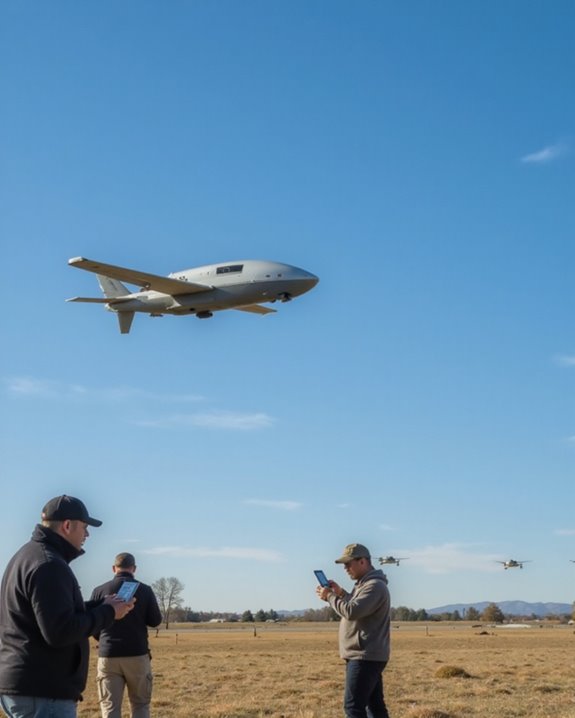
Just how fast can these flying marvels actually go? The answer might surprise you! While commercial drones typically cruise at 40-60 MPH, racing models are shattering expectations. The Swiss Student’s Drone currently holds the ultimate record at a blistering 346.63 MPH, followed by Peregreen 2 at 298.47 MPH. That’s faster than many sports cars!
Future speeds look even more promising, thanks to innovations in Aerodynamic Materials like carbon fiber frames and specialized propellers that slice through air resistance. Battery Enhancements are equally essential, with lighter power sources enabling longer bursts of extreme velocity. Engineers are constantly refining these elements, creating sleeker designs that maximize efficiency while maintaining stability. The race for speed continues, and tomorrow’s drones will likely make today’s record-breakers seem positively sluggish!
Frequently Asked Questions
Can Drone Speed Affect Battery Life?
Drones operating at 15+ mph experience up to 30% faster battery drain. Speed greatly increases power consumption due to air resistance, creating a direct efficiency impact as motors work harder to maintain velocity.
How Do Altitude Changes Impact a Drone’s Maximum Speed?
Increasing altitude reduces air density, diminishing propeller thrust and lowering maximum speed. Regulatory altitude limits typically prevent operations where significant speed loss occurs. Weight, motor power, and aerodynamic design are key speed factors at varying elevations.
Are There Speed Differences Between Indoor and Outdoor Drone Operations?
Indoor and outdoor drone operations differ markedly in speed parameters. Indoor environments require slower speeds for maneuverability around obstacles, while outdoor settings allow faster speeds with enhanced stability for covering greater distances.
Do Camera Attachments Significantly Reduce Drone Speed Capabilities?
Camera attachments typically reduce drone speed capabilities by 10-30%. Camera drag increases wind resistance, altering aerodynamics and requiring more power. Weight and balance changes are significant speed factors affecting performance and handling.
Can Software Updates Improve a Drone’s Maximum Speed?
Software updates rarely improve a drone’s maximum speed. While firmware optimization and code efficiency enhancements may fine-tune performance and responsiveness, physical hardware limitations ultimately determine top speed rather than software modifications.

